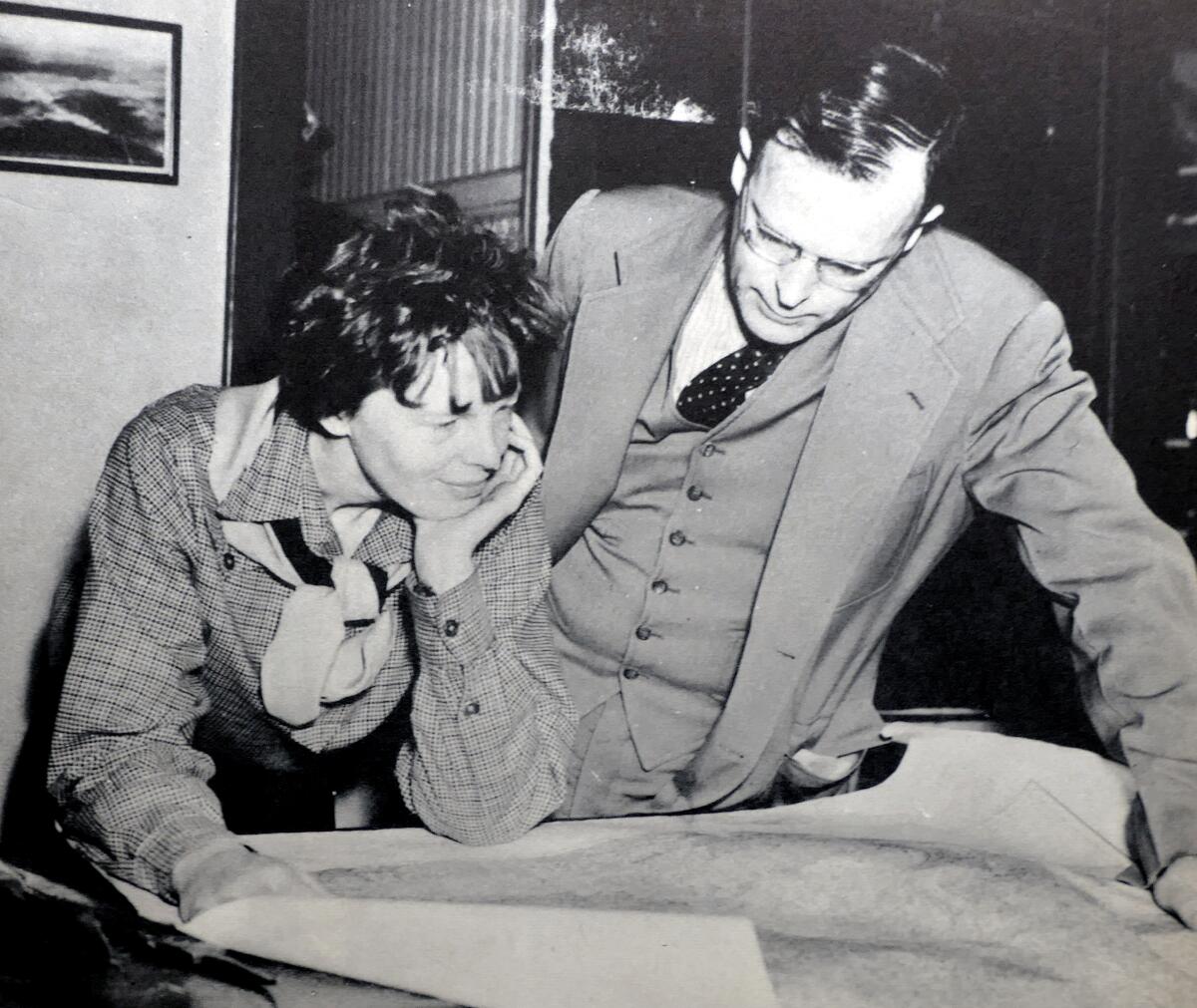‘The Aviator and the Showman’ untangles Amelia Earhart’s fateful marriage — and thrill-seeking ambition

- Share via
Book Review
The Aviator and the Showman: Amelia Earhart, George Putnam, and the Marriage That Made an American Icon
By Laurie Gwen Shapiro
Viking: 512 pages, $35
If you buy books linked on our site, The Times may earn a commission from Bookshop.org, whose fees support independent bookstores.
“Sex, violent death, and mystery. If your life has one of these things people might be interested. If it has two, now you’re tabloid fodder. If it has three, you’re Amelia Earhart.” So begins Laurie Gwen Shapiro’s enticing “The Aviator and the Showman,” a vibrant account of the courtship and union of the famous pilot and her publisher husband whose intrusive management of his wife’s career may have cost her life. Shapiro dexterously untangles the Gordian knot of their entwined passions, shared ambitions and business bottom lines.
The affianced Earhart and the married George Palmer Putnam met in his Manhattan office in the spring of 1928. She was 30, he a decade older. While she’d grown up in the Midwest and spent time in California, she was currently living in Boston, employed as a social worker and indulging an enthusiasm for flying in her spare time. Although she was still honing her skills, her tall, lean beauty, capped with a tousled jazz-age bob, caught Putnam’s attention. The previous year the publishing exec had rushed out Charles Lindbergh’s bestselling “We,” which detailed Lindy’s solo flight across the Atlantic; he was hoping to achieve a similar success for Earhart. Would she be willing to hitch a ride with a crew that summer?

Shapiro then circles back to their biographies. Earhart was born into a solidly middle-class family in Kansas, close to her younger sister, Muriel, but her father’s job failures and alcoholism uprooted the Earharts, undermining the girls’ educations. Earhart was full of mischief and adventure, a natural leader with a modesty instilled by her mother, who was prone to invoking her Quaker background when it suited her. Despite financial insecurity, both parents encouraged their daughters to pursue their dreams, however unconventional — their feminist, progressive spirit guided Earhart like a compass.
A stint in Toronto kindled her desire to fly. After another move to Los Angeles, she took lessons from a female instructor, learning basics, but it was a hobby compared to her chosen vocation. She was also juggling men, among them the boyish Sam Chapman, whose proposal she’d tentatively accepted, to a wealthy 64-year-old who showered her with pricey presents, such as an automobile. (Earhart was susceptible to luxury items, which Putnam later exploited). Shapiro’s tone is conversational, luring us into a rich story about American media.
Her portrait of Putnam is equally magnetic. A large, expansive man and junior partner in a dynastic firm, “Gyp” had a knack for packaging authors as mass-market products, adept at negotiating deals from London to New York to Hollywood. His troubled marriage to Dorothy Binney Putnam, an heiress, did not restrain him from skimming her fortune to defray his expenses. He recruited Earhart to become the first woman to cross the Atlantic by air, though she spent the duration squeezed between gasoline tanks, “feeling like a faker due to George’s excessive promotion of her as a pilot.” Her return to the U.S. was a Putnam-orchestrated extravaganza that eclipsed the flight: “Wherever Amelia went, she ignited a frenzy of excitement that not only enraptured audiences but also allowed George to revel in her reflected glory,” Shapiro notes. “He was invigorated by her carefree and glamorous aura. Amelia was the ‘it girl’... urbane, relaxed, and effortlessly charming.” Their affair triggered Putnam’s divorce, and the pair married in 1931, residing at his estate in Rye, N.Y.
“The Aviator and the Showman” is a lavish, layered narrative, a primer on early aviation and the transition of publishing from genteel carriage trade to an industry increasingly reliant on blockbusters. Putnam mastered the moment; to this day, corporations demand photogenic authors, high-stakes publicity, spreadsheet tweaks and magical thinking. From Big Five houses to small presses, from Amazon to Barnes & Noble to pocket independent stores: We are all descendants of George Putnam.
A short black-and-white film of Amelia Earhart before her last flight has surfaced.
Earhart never lost her eye for attractive men, though, tipping Shapiro into the occasional cliché or purple flourish. “Captain Manning’s handsome good looks and gentlemanliness greatly appealed to Amelia,” she writes. “Sam Chapman who? Could a budding romantic connection from these intoxicating nights at sea grow after they docked?” Putnam was jealous of his wife’s flirtations, and tinkered with her schedule accordingly.

Shapiro chronicles the couple’s reach, as Putnam stamped Amelia’s imprimatur onto (white) American womanhood, a prototype still among us: role model for younger women, professional and practical, efficient by day, elegant by night. He spun her myth into fashion and merchandise, even a brief editorial gig at Cosmopolitan. (Earhart loved poetry but was no gifted writer herself.) They bought expensive cars, a stylish house in Toluca Lake and Amelia’s signature Lockheed Electra. Dollar signs in his eyes, Putnam helped Earhart assemble a team for her 1937 global trek, including her trusted technical advisor Paul Mantz, and Fred Noonan, a seasoned navigator with a taste for liquor. The author’s recreation of Earhart’s final odyssey, manipulated by Putnam’s controlling personality, will seem familiar, yet Shapiro teases out two factors: the Electra’s faulty transmissions and Earhart’s limitations (she never bothered to learn Morse code).
“The Aviator and the Showman” leaves no doubt about Earhart’s disappearance: She misjudged her gasoline reserves, panicked and crashed near tiny Howland atoll. The wreck of the Electra sits on the Pacific’s floor, Shapiro asserts, at a level deeper than the ruins of the Titanic. One reporter’s “most scathing critique was directed toward George Palmer Putnam, whom he saw as motivated more by profit than by his wife’s safety, a sentiment fueled by seeing cabled messages pressuring Amelia to hasten her journey for a lucrative radio deal.”
Surely, the grainy image had to be Amelia Earhart’s long-lost plane, 16,000 feet beneath the surface of the Pacific Ocean. This week, Tony Romeo announced that the discovery amounted to less than they had hoped.
Putnam’s post-Earhart life was a roller coaster of cash woes and notoriety; the following year he staged his own kidnapping, alienating his stodgy publishing community. His appetite for publicity was insatiable. “The Aviator and the Showman” reveals the magnitude of our celebrity worship, the wonder of what we don’t understand. Shapiro captures the thrill of a leap into the unknown, recalling the works of Jon Krakauer and Sebastian Junger.
Cain is a book critic and the author of a memoir, “This Boy’s Faith: Notes From a Southern Baptist Upbringing.” He lives in Brooklyn, New York.
More to Read
Sign up for our Book Club newsletter
Get the latest news, events and more from the Los Angeles Times Book Club, and help us get L.A. reading and talking.
You may occasionally receive promotional content from the Los Angeles Times.











